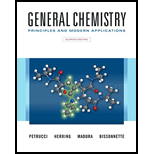
(a)
Interpretation:
The equations for the dissolution and
Concept introduction:
Silver have two stable oxidation states as +1 and +2. Silver has higher reduction potentials than H+. Silver is durable and resistant to corrosion. Silver is a group 11 metal and does not react with HCl. But Ag and Cu can react with concentrated sulfuric or nitric acid.
(b)
Interpretation:
It should be shown that the oxidation reduction reaction is indeed spontaneous
Concept introduction:
In an
If oxidation takes place on an electrode, that electrode is called anode. The species in that electrode remove electrons and itself gets oxidized.
If reduction takes place on an electrode, that electrode is called cathode. The species in that electrode absorbs electrons and itself gets reduced.
The electrode potential of cell can be calculated as follows:
When E0cell is positive the forward reaction is spontaneous.
Want to see the full answer?
Check out a sample textbook solution
Chapter 23 Solutions
General Chemistry: Principles And Modern Applications Plus Mastering Chemistry With Pearson Etext -- Access Card Package (11th Edition)
- The following cell was found to have a potential of —0.492 V: Ag|AgCl(sat’d)||HA(0.200 M),NaA(0.300 M)|H2(1.00 atm),Pt Calculate the dissociation constant of HA, neglecting the junction potential.arrow_forward(i) Name the method used for the refining of titanium. (ii) What is the role of Zn in the extraction of silver? (iii) Reduction of metal oxide to metal becomes easier if the metal obtained is in liquid state. Why?arrow_forward(a) What is the percentage of MnO2 in a pyrolusite ore if a sample weighing 0.4000 g is treated with a 0.6000 g of pure H2C2O4.2H20 and dilute H2SO4 and after reduction has taken place (MnO2 + H2C2O4 + 2H+ Mn2+ + 2CO2 + 2H2O), the excess oxalic acid requires 26.26 mL of 0.1000 N KMNO4 for titration? (b) If pure As2O3 were used instead of oxalic acid, how many grams would be required in order for the other numerical data to remain the same?arrow_forward
- Ag (s) | Ag + (0.015 M) || Fe3 + (0.055 M), Fe2 + (0.045 M) | Pt (s) a) Write down the reduction and oxidation half-cells and calculate the E ° Ag⁺ / Ag = +0,800 V and E ° Fe³⁺ / Fe²⁺ = +0,771 V at 298 K). b) Calculate ∆G ° and equilibrium constant (K). Is the reaction voluntary and how does it occur? Explain.arrow_forwardThe electrochemistry of metal complexes reflects the underlying chemical equilibria involved in their formation. A chemist can use the measured electrochemistry to determine the solubility product of a metal-ion complex, or vice versa. Calculate the electrode potential of the following half-cell involving the reduction of the Cu(I)-thiocyanate complex to copper metal, Cu(0). CuSCN (sat’d), SCN– (0.0300M) | Cu The solubility product, KSP, of CuSCN is 1.77 x 10-11 = [Cu+][SCN–]arrow_forwardBalance the redox reaction between acidified potassium tetraoxomanganate and iron (ii) tetraoxosulphate (vi)arrow_forward
- Describe the preparation of KMn04 from pyrolusite ore (MnO4). How does the acidified permanganate solution react with the following: (i) Fe2+ ions (ii) Oxalic acid (C2H204) Write the ionic equations for the reactions involved.arrow_forwardA 1.000 g sample containing chlorides, iodides and inert materials was treated with dilute nitric acid followed by AgNO3. A precipitate of AgCl (143.32) and AgI (234.77) was produced and weighs 0.9238 g. On heating in a current of Cl2, the AgI is converted to AgCl, and the resulting product weighs 0.7238 g. Find the percentage of a) NaI (149.89) and b) NaCl (58.44) in the samplearrow_forwardThe amount of iron in a meteorite is determined by a redox titration using KMnO4 as the titrant. A 0.4185-g sample is dissolved in acid and the liberated Fe3+ quantitatively reduced to Fe2+ using a Walden reductor. Titrating with 0.02500 M KMnO4 requires 41.27 mL to reach the end point.(a) Determine the %w/w Fe2O3 (MW = 159.69 g/mol) in the sample of meteorite.(b) Determine the %w/w Fe3O4 (MW = 231.533 g/mol) in the sample of meteorite.arrow_forward
- Magnesium is obtained by electrolysis of molten MgCl2.(a) Why is an aqueous solution of MgCl2 not used in theelectrolysis? (b) Several cells are connected in parallel byvery large copper bars that convey current to the cells.Assuming that the cells are 96% efficient in producing thedesired products in electrolysis, what mass of Mg is formedby passing a current of 97,000 A for a period of 24 h?arrow_forward1.) A sodium sulfate solution was electrolyzed using inert Pt electrodes. The cathode reaction was 2H2O + H2+2OH^-. If a current of 3.0 amp was used for 30 min, what weight of H2O gas would be produced? 2.) What volume of H2 gas at STP would be produced during the passage of 30,000 Coul in the electrolysis of H2O? 3.) Give the notation for the cell that utilizes the reaction: (a) Cl2 (g)+ 2 I^-(aq) to 2 Cl^-(aq)+I2(s), (b) what is the E^o for the cell? (c) which electrode is the cathode? 4.) The standard electrode potential fornthe Fe^2+ to Fe^(3+) + e - half reaction is -0.770V. (a) Using the Nernst equation [E=E^o - (0.059/n) log [Oxid]/[Red]]. Calculate the voltage of this half cell when the [Fe^3+] is 1.0 x 10^-3 and [Fe^2+] is 1.0 x 10 ^ -1. (b) Calculate the approximate equilibrium constant (K) for the half reaction.arrow_forwardWhat is linkage isomerisation and why can it be important?arrow_forward
 Chemistry by OpenStax (2015-05-04)ChemistryISBN:9781938168390Author:Klaus Theopold, Richard H Langley, Paul Flowers, William R. Robinson, Mark BlaserPublisher:OpenStax
Chemistry by OpenStax (2015-05-04)ChemistryISBN:9781938168390Author:Klaus Theopold, Richard H Langley, Paul Flowers, William R. Robinson, Mark BlaserPublisher:OpenStax Principles of Instrumental AnalysisChemistryISBN:9781305577213Author:Douglas A. Skoog, F. James Holler, Stanley R. CrouchPublisher:Cengage Learning
Principles of Instrumental AnalysisChemistryISBN:9781305577213Author:Douglas A. Skoog, F. James Holler, Stanley R. CrouchPublisher:Cengage Learning Principles of Modern ChemistryChemistryISBN:9781305079113Author:David W. Oxtoby, H. Pat Gillis, Laurie J. ButlerPublisher:Cengage Learning
Principles of Modern ChemistryChemistryISBN:9781305079113Author:David W. Oxtoby, H. Pat Gillis, Laurie J. ButlerPublisher:Cengage Learning Chemistry: The Molecular ScienceChemistryISBN:9781285199047Author:John W. Moore, Conrad L. StanitskiPublisher:Cengage Learning
Chemistry: The Molecular ScienceChemistryISBN:9781285199047Author:John W. Moore, Conrad L. StanitskiPublisher:Cengage Learning



